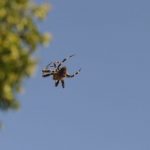 Creepy
Creepy  Creepy
Creepy  Technology
Technology 10 Scientific Breakthroughs of 2025 That’ll Change Everything
 Our World
Our World 10 Ways Icelandic Culture Makes Other Countries Look Boring
 Misconceptions
Misconceptions 10 Common Misconceptions About the Victorian Era
 Mysteries
Mysteries 10 Strange Unexplained Mysteries of 2025
 Miscellaneous
Miscellaneous 10 of History’s Most Bell-Ringing Finishing Moves
 History
History 10 Great Escapes That Ended Right Back in Captivity
 Weird Stuff
Weird Stuff 10 Fascinating Things You Might Not Know About Spiders
 Food
Food 10 Everyday Foods You Didn’t Know Were Invented by the U.S. Military
 History
History 10 Odd Things Colonial Americans Kept at Home
 Creepy
Creepy 10 More Representations of Death from Myth, Legend, and Folktale
 Technology
Technology 10 Scientific Breakthroughs of 2025 That’ll Change Everything
 Our World
Our World 10 Ways Icelandic Culture Makes Other Countries Look Boring
Who's Behind Listverse?

Jamie Frater
Head Editor
Jamie founded Listverse due to an insatiable desire to share fascinating, obscure, and bizarre facts. He has been a guest speaker on numerous national radio and television stations and is a five time published author.
More About Us Misconceptions
Misconceptions 10 Common Misconceptions About the Victorian Era
 Mysteries
Mysteries 10 Strange Unexplained Mysteries of 2025
 Miscellaneous
Miscellaneous 10 of History’s Most Bell-Ringing Finishing Moves
 History
History 10 Great Escapes That Ended Right Back in Captivity
 Weird Stuff
Weird Stuff 10 Fascinating Things You Might Not Know About Spiders
 Food
Food 10 Everyday Foods You Didn’t Know Were Invented by the U.S. Military
 History
History 10 Odd Things Colonial Americans Kept at Home
10 Animals With Incredible Eyes
According to scientists, eyes evolved around 540 million years ago as simple light-detecting organs. Today, vision is the most important sense for many animals, humans included, and they have become incredibly varied and complex. Take a look at some of the strangest and most incredible eyes in the animal kingdom.
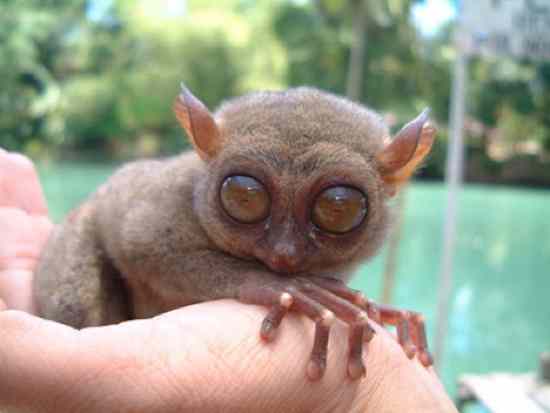
The tarsier is a small (about squirrel-sized) nocturnal primate found in the rainforests of South-Eastern Asia. It is the only fully predatory primate in the world, feeding on lizards and insects, and is even known to catch birds in mid-flight. However, its most remarkable feature is its enormous eyes, the largest of any mammal relative to body size. If your eyes were proportionally as big as those of the tarsier, they would be the size of grapefruits. These enormous eyes are fixed in the skull and can’t turn in their sockets. To compensate for this, the tarsier has a very flexible neck and can rotate its head 180 degrees, just like an owl, to scan for potential prey or predators.
With each eye weighing more than its brain, the tarsier has extremely acute eyesight and superb night vision; it has even been suggested that they may be able to see ultraviolet light. On the other hand, they seem to have very poor color vision, as is the case with many nocturnal animals (including house cats and owls, for example).
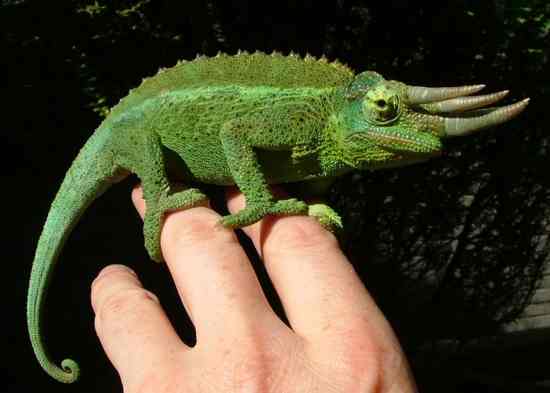
Chameleons are famous for their ability to change color, which helps them communicate and express their intentions or mood to other chameleons (only a few species use color-changing as camouflage). These lizards also have very unusual eyes; their eyelids are fused and cover almost the entire eyeball, except for a small hole to let the pupil see through. Each eye can be moved independently from the other so that the chameleon can scan for prey and potential threats at the same time. This also means that the chameleon has a full 360-degree field of vision.
When the chameleon sees a potential prey (usually an insect, although the largest species are known to devour mice and other small vertebrates), it focuses both eyes in the same direction, gaining stereoscopic vision—very important if we consider that the chameleon captures prey by shooting out its tongue at high speed, a technique that requires a very precise distance and depth perception. Chameleons have very sharp eyesight, being able to see an insect several meters away, and just like the tarsier, they can see ultraviolet light.
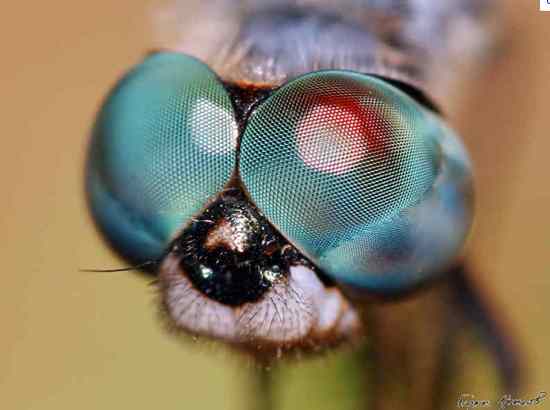
The dragonfly, possibly the most formidable aerial hunter among insects, also has some of the most amazing eyes in the animal world. They are so big that they cover almost the entire head, giving it a helmeted appearance and a full 360-degree field of vision. These eyes are made up of 30,000 visual units called ommatidia, each containing a lens and a series of light-sensitive cells. Their eyesight is superb; they can detect colors and polarized light and are particularly sensitive to movement, allowing them to quickly discover any potential prey or enemy.
Some dragonfly species that hunt at dusk can see perfectly in low light conditions when humans can barely see anything. Not only that, but dragonflies also have three smaller eyes called ocelli which can detect movement faster than the huge compound eyes can. These ocelli quickly send visual information to the dragonflies’ motor centers, allowing it to react in a fraction of a second and perhaps explaining the insect’s formidable acrobatic skills. Although dragonflies are not the only insects with ocelli (some wasps and flies have them, too), they do have the most developed ones.
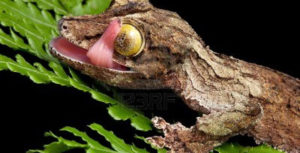
Leaf-tailed Geckos have pretty surreal-looking eyes; their pupils are vertical and have a series of “pinholes” which widen at night, allowing these lizards to pick up as much light as possible. These eyes also have many more light-sensitive cells than human eyes, giving the animal the ability to detect objects and even to see colors at night.
To give you an idea of the gecko’s amazing night vision, let us just say that, while cats and sharks can see six and ten times better than humans, respectively, the Leaf-Tailed Gecko and other nocturnal gecko species can see up to 350 times better than we can in dim light! Leaf-tailed Geckos also have a series of strange, intricate eye patterns, which provide camouflage. These lizards lack eyelids; a transparent membrane protects their eyes, and geckos are often seen cleaning this membrane with their tongue.
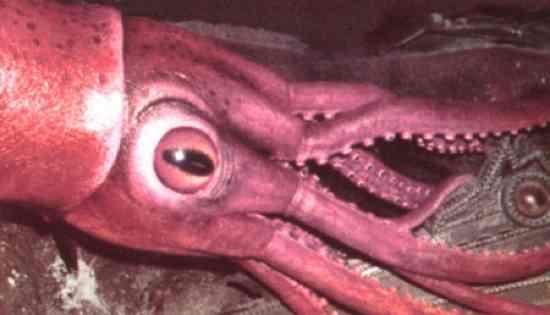
Not to be confused with the better known but smaller Giant Squid, the Colossal Squid is the largest invertebrate known to science. It also has the largest eyes in the animal kingdom. Each of the Colossal Squid’s eyes can be up to 30 cm across, bigger than a dinner plate, and having a lens the size of an orange. These huge eyes allow the squid to see in dim light conditions, very useful for an animal that spends most of its time hunting at 2000 meters below the surface.
It must be mentioned that only sub-adult Colossal Squids have been captured and studied thus far; full-grown Colossal Squids may grow up to 15 meters long. These giants would have even bigger eyes. Unlike the Giant Squid, the Colossal Squid has stereoscopic vision, having a greater ability to judge distances. Even more amazing, each eye has a built-in “headlight,” an organ known as a photophore, which can produce light so that whenever the Colossal Squid focuses its eyes to the front, the photophores produce enough light for the squid to see its prey in the dark.
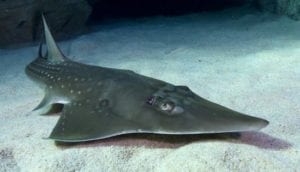
The Giant Guitarfish is named for its rather guitar-like shape—the creature looks a bit like a ray stuck to the front of a shark. But that’s not the oddest thing about this fish. Giant Guitarfish don’t have eyelids, and instead, they’ve developed one powerful muscle to pull their eyes back into their head. The Giant Guitarfish can retract its eyeballs nearly 1.6 inches back into its head, almost as far as the diameter of the eyeball itself.
These sea creatures hunt for prey, like crabs and small fish, in the sandy bottoms of tropical oceans. So, when thrashing prey kicks sand or bits of coral at it, the Giant Guitarfish can protect itself. As alien as it sounds, other animals can retract their eyeballs as well. Frogs can retract them about half the diameter of the eyeball, the second most impressive distance measured after the guitarfish. Surprisingly, you can also retract your eyeballs when you close your eyes, but it’s only about 0.04 inches.
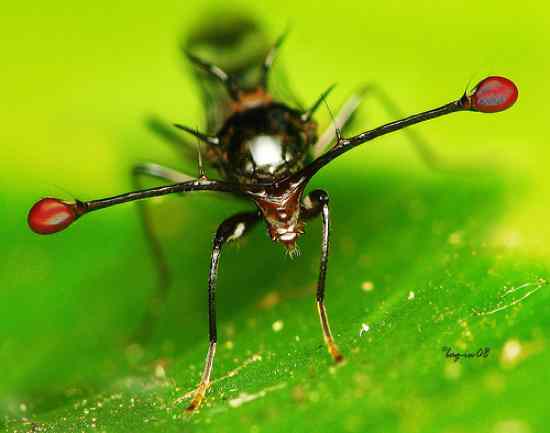
These small but spectacular creatures are mostly found in the jungles of South East Asia and Africa, with a few species also found in Europe and North America. They get their name from the long projections from the sides of the head with the eyes and antennae at the end. Male flies usually have much longer stalks than females, and it has been confirmed that females prefer males with long eyestalks. Males during the mating season often stand face to face and measure their eyestalk’s length; the one with the greatest “eye span” is recognized as the winner.
Male Stalk-eyed flies also have the extraordinary ability to enlarge their eyestalks by ingesting air through their mouth and pumping it through ducts in the head to the eyestalks. They do this mostly during mating season. Here’s an amazing video of the male stalk eyed fly, newly emerged from its cocoon, actively enlarging his eyestalks:
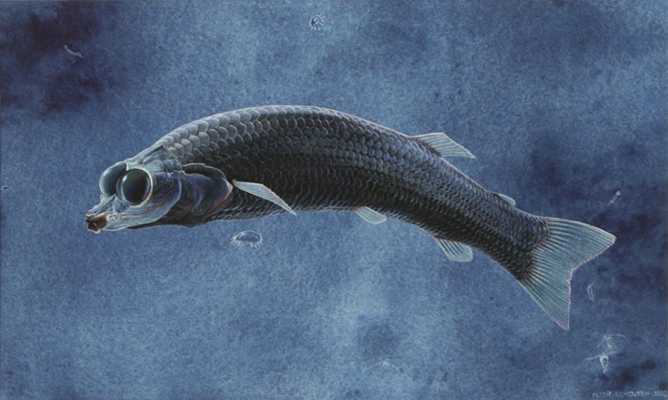
The Spookfish is a deep-water, ghostly-looking fish with some of the most bizarre eye structures known to science. Each eye has a lateral swelling called a diverticulum, separated from the main eye by a septum. While the main part of the eye has a lens and functions similarly to other animal eyes, the diverticulum has a curved, composite mirror composed of many layers of what seems to be guanine crystals. This “mirror” is far superior at gathering light than the normal eye as the diverticulum reflects light and focuses it onto the retina, allowing the fish to see both up at down at the same time.
The spookfish is the only vertebrate known to use a mirror eye structure and the usual lens to see. Spookfish are found worldwide but are rare to see since they spend most of their lives at a depth of 1000-2000 meters. They feed on small crustaceans and plankton and measure about 18 cm in length.
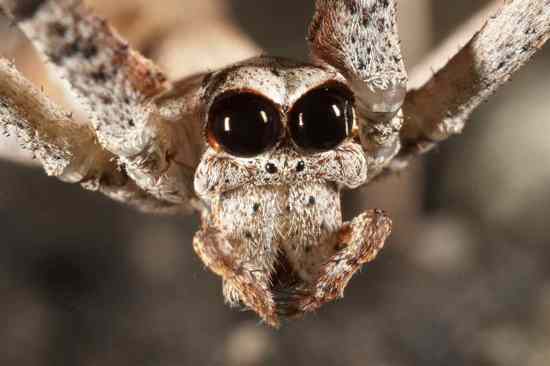
Spiders are popularly known for having many eyes (although this varies greatly among the different species, with some having two, four, six, or eight eyes). The Ogre-faced spider has six eyes, but it looks as if it only had two because the middle pair is greatly enlarged. This is an adaptation for a nocturnal lifestyle. Ogre-faced Spiders have superb night vision not only because of their huge eyes but also because of an extremely light-sensitive layer of cells covering them.
This membrane is so sensitive, in fact, that it is destroyed at dawn, and a new one is produced every night. Ogre-faced Spiders are unusual because they can see perfectly at night even though they lack a tapetum lucidum, a reflective membrane that helps other spiders (and other predators such as cats) see in low-light conditions. As a matter of fact, scientists believe that Ogre-faced Spiders have better night vision than cats, sharks, or even owls (which can see up to 100 times better than humans at night!).
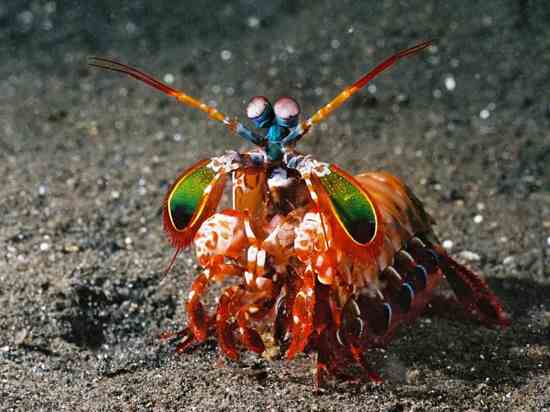
And finally, we get to the animal with the weirdest and most amazing eyes in the world. The Mantis Shrimp is not actually a shrimp but a different kind of crustacean from the Stomatopoda order. Known for their aggressiveness and formidable weaponry (they have an extremely sharp and powerful claw and can split a human finger in two or even break a glass aquarium with one single strike), Mantis Shrimp are voracious predators found mostly in tropical waters.
Their eyes are compound, like those of the dragonfly, although they have a far smaller number of ommatidia (about 10.000 per eye). However, in the Mantis Shrimp, each ommatidia row has a particular function. For example, some of them are used to detect light, others to detect color, etc.
Mantis Shrimp have much better color vision than humans (their eyes have 12 types of color receptors, whereas humans have only three) and ultraviolet, infrared, and polarized light vision, thus having the most complex eyesight of any animal known. The eyes are located at the end of stalks and can be moved independently from each other, rotating up to 70 degrees. Interestingly, the visual information is processed by the eyes themselves, not the brain.
Even more bizarre, each Mantis Shrimp’s eyes are divided into three sections, allowing the creature to see objects with three different parts of the same eye. In other words, each eye has “trinocular vision” and complete depth perception, meaning that if a Mantis Shrimp lost an eye, its remaining eye would still be able to judge depth and distance as well as a human with his two eyes. Scientists are only starting to understand the mysteries of Stomatopod vision. For the moment, we can only imagine what the world really looks like to a Mantis Shrimp.
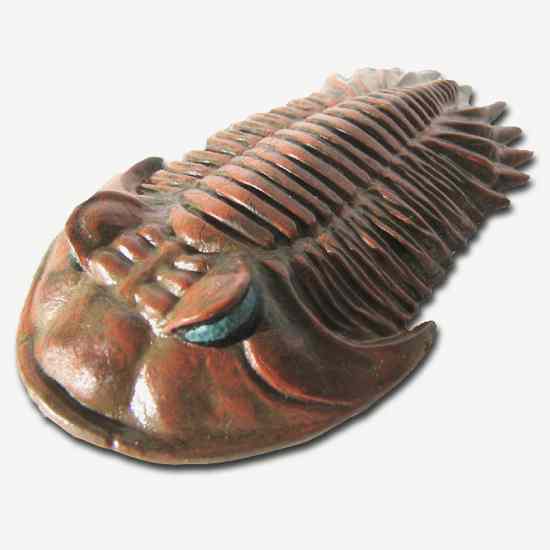
Trilobites were one of the most successful animal groups of all time, thriving for almost 300 million years before dinosaurs appeared on Earth. Although some species were eyeless, most of them had compound eyes similar to those of insects. The weird thing about trilobite eyes is that their lenses were made of inorganic calcite crystal, a mineral that is also the main component of limestone and chalk. In its purest form, calcite is clear, thus being an adequate if unorthodox material for an eye lens.
These crystal eyes are unique to trilobites, with the compound eyes of modern invertebrates being made of chitin, an organic substance. Due to their unusual composition, trilobite eyes were completely rigid and could not be adjusted to focus. Instead, the trilobite corrected its focus with an internal eye mechanism that solved any potential problems caused by the mineral lens and gave the trilobite such good vision that it could keep both close and distant objects in focus at the same time.
As if that wasn’t bizarre enough, some trilobites had really weird-looking eyes. A few had their eyes at the end of long projections, just like the Stalk-eyed Fly, while others had overhanging “eyeshades” on top of the eye, protecting it from bright sunlight. Being made of calcite, trilobite eyes are fossilized easily, and therefore we probably know more about trilobite eyes and vision than those of any other prehistoric creature.
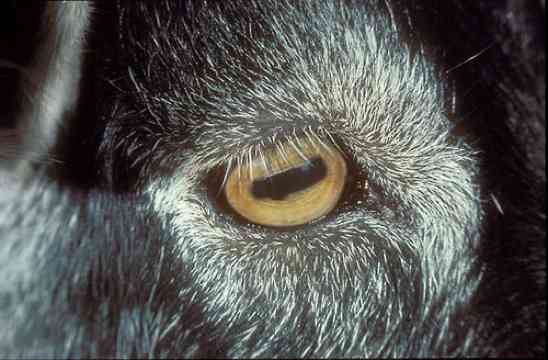
We all imagine pupils to be round—as they are the type we see most often (on humans)—but goats (and most other animals with hooves) have horizontal slits, which are nearly rectangular when dilated. This gives goats vision covering 320–340 degrees. This means they can see virtually all around them without moving (humans have vision covering 160–210 degrees). Consequently, animals with rectangular eyes can see better at night due to having larger pupils that can be closed more tightly during the day to restrict light. Interestingly, octopuses also have rectangular pupils. [Courtesy of 10 Weird and Wonderful Oddities of Nature]
